

The catalyst that removes CO2 and produces hydrocarbons. A team of researchers from Canada and the U.S. has developed a catalyst that quickly and efficiently converts carbon dioxide into simple chemicals.

In this way, they transform the most important greenhouse gas into useful products for industry. “The technology of water electrolysers is well known: they transform water and electricity into hydrogen and oxygen, but in our case, we add CO2 to the cocktail and, instead of producing hydrogen, we can generate various hydrocarbons, such as ethylene, which is the most widely used organic compound worldwide,” researcher F. It's official: time crystals are a new state of matter, and now we can create them. Earlier this year, physicists had put together a blueprint for how to make and measure time crystals - a bizarre state of matter with an atomic structure that repeats not just in space, but in time, allowing them to maintain constant oscillation without energy.
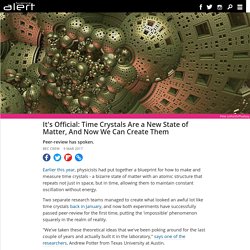
Two separate research teams managed to create what looked an awful lot like time crystals back in January, and now both experiments have successfully passed peer-review for the first time, putting the 'impossible' phenomenon squarely in the realm of reality. This Spray Can Turn Any Surface Into A Touch Screen. Tired of pesky small touch pads?

Well, this spray might be your savior, allowing a wide variety of surfaces to become touch sensitive. The technology, called Electrick, was developed by scientists from Carnegie Mellon University in Pennsylvania, with the findings published in an open access paper. The spray consists of an electrically conductive carbon-based material. When applied to an object, it allows it to conduct electricity.
A New Transparent, Conductive Material Is Set to Revolutionize Our Electronics. A New Material Researchers at the University of Minnesota have discovered a new material that could change technology as we know it.
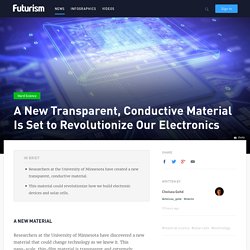
This nano-scale, thin-film material is transparent and extremely conductive. Many common electronics, like smartphones and solar cells, use transparent conductors. Scientists Have Found the 'Holy Grail' of Physics, Metallic Hydrogen. Two Harvard scientists have succeeded in creating an entirely new substance long believed to be the “holy grail” of physics — metallic hydrogen, a material of unparalleled power that could one day propel humans into deep space.
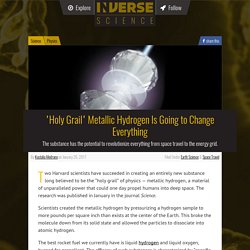
The research was published in January in the journal Science. Scientists created the metallic hydrogen by pressurizing a hydrogen sample to more pounds per square inch than exists at the center of the Earth. This broke the molecule down from its solid state and allowed the particles to dissociate into atomic hydrogen. The best rocket fuel we currently have is liquid hydrogen and liquid oxygen, burned for propellant. Scientists Finally Observed Time Crystals—But What the Hell Are They? Scientists Have Found the 'Holy Grail' of Physics, Metallic Hydrogen. Study: Epoxy makes transparent wood stronger than glass. COLLEGE PARK, Md., May 19 (UPI) -- Materials scientists are giving wood a makeover.
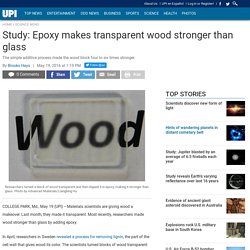
Last month, they made it transparent. Most recently, researchers made wood stronger than glass by adding epoxy. In April, researchers in Sweden revealed a process for removing lignin, the part of the cell wall that gives wood its color. The scientists turned blocks of wood transparent by boiling them for two hours in a concoction of water, sodium hydroxide and several other chemicals. Scientists at the University of Maryland built on the Swedish researchers' work, using the same color-removing process before adding their own twist -- pouring epoxy over the transparent wood block.
The simple additive process made the block four to six times stronger -- stronger than glass. Researchers believe the new material could be used to make more resilient windows and other optical materials, like solar panels. This piping helps channel light passing through the wood. Crystal with "Forbidden Symmetry" Found in 4.5-Billion-Year-Old Meteorite. A crystal with an “unorthodox” arrangement of atoms has been discovered inside an ancient meteorite that crashed into a remote area of northeastern Russia thousands of years ago.
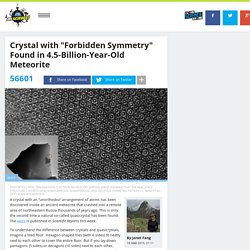
This is only the second time a natural so-called quasicrystal has been found. The work is published in Scientific Reports this week. Metal Foam Armor Disintegrates Bullets. Bad news for bullets this week: Researchers at North Carolina State University have developed a super strong armor material that literally turns bullets to dust upon impact.
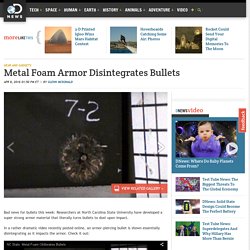
In a rather dramatic video recently posted online, an armor-piercing bullet is shown essentially disintegrating as it impacts the armor. Check it out: The armor plating shown in the video is made in part from composite metal foams, or CMFs, which are both lighter and stronger than traditional metal plating used in body and vehicle armor. Jacket Acts Like Adventure Armor. Dutch researchers have created flexiramics—flexible ceramics for circuit boards. Andrii Degeler A few sheets of flexiramics Andrii Degeler A few sheets of flexiramics Andrii Degeler University of Twente campus Andrii Degeler Eurekite CEO Gerard Cadafalch Gazquez Andrii Degeler A few sheets of flexiramics Modern chemistry can sometimes produce the most unlikely things, including materials familiar to everyone but with totally new—and useful—properties.

UCLA researchers create exceptionally strong and lightweight new metal. UCLA Scifacturing Laboratory At left, a deformed sample of pure metal; at right, the strong new metal made of magnesium with silicon carbide nanoparticles.

Each central micropillar is about 4 micrometers across. A team led by researchers from the UCLA Henry Samueli School of Engineering and Applied Science has created a super-strong yet light structural metal with extremely high specific strength and modulus, or stiffness-to-weight ratio. The new metal is composed of magnesium infused with a dense and even dispersal of ceramic silicon carbide nanoparticles. It could be used to make lighter airplanes, spacecraft, and cars, helping to improve fuel efficiency, as well as in mobile electronics and biomedical devices. Researchers successfully fabricate a metamaterial using a lotus leaf as a template.
Metamaterials are man-made substances whose properties are determined by their meticulously-designed structure. For example, metamaterials can be fabricated so that they interact with light or sound in a specific way. Unique surface structures play a vital role in metamaterials, and scientists have begun looking to nature itself for patterned surfaces from which to draw inspiration.
Scientists Discover New Phase Of Matter. A new ordered phase of matter has been discovered by Caltech researchers, which has big implications for superconductors – materials that conduct electricity with no resistance. The team thinks that this phase happens just before a material turns superconductive. Scientists are interested in superconductors as they transmit electricity and signals without losing energy. Researchers create blackest material ever made. (Phys.org)—A team of researchers at King Abdulla University of Science and Technology in Saudi Arabia has made the blackest material ever created by us human beings. As they note in their paper published in Nature Nanotechnology, the idea for how to create the material came, from of all sources, an all white cyphochilus beetle. As the researches also note, it is likely impossible to create the perfect black material, one that absorbs all of the energy that strikes it, and then emits it without any lose of energy.
Sequential Self-Folding Structures by 3D Printed Digital Shape Memory Polymers : Scientific Reports. Untitled. Optically Clear Aluminum Provides Bulletproof Protection. While the U.S. Navy is busy with the development of a new bulletproof material called Spinel, Surmet Corporation is already commercially producing its own version called ALON®. Technically known as aluminum oxynitride, Star Trek fans may be more familiar with the term “transparent aluminum” first proposed by Scotty in the 1986 movie, Star Trek IV: The Voyage Home. While ALON isn’t quite what Scotty had in mind (it’s not truly a transparent metallic aluminum, but rather a transparent aluminum-based ceramic), it’s pretty darn close. Developed by Raytheon, ALON begins as a powder, which is then molded and baked in very high heat. The heating process causes the powder to liquefy and cool quickly, leaving the molecules loosely arranged, as if still in liquid form.
Comparing Aluminum Armor to Traditional Bulletproof Glass. Scientists discover whole new state of matter. Most people are familiar with some of the common states of matter: solids, liquids and gases. Scientists also recognize a fourth state of matter — plasma — that is commonly observable here on Earth, as well as a host of other states that can only be created in the lab, such as Bose–Einstein condensates and neutron-degenerate matter. Jahn-Teller metals can now be added to this list, a state which appears to have the properties of an insulator, superconductor, metal and magnet all wrapped into one.
It's the material's superconductivity which might be the most interesting trait, however. Zombie Cyborg Wood May Lead to Better Night-Vision Cameras. Watch: This new type of 3D printing was inspired by Terminator 2. This new 3D printing technology looks like science fiction. Liquid metal brings shape-shifting robot a step closer - tech - 10 March 2015. Self-Assembly Lab. Oxford University researchers create new 3D printed 'soft material' that could replace human tissue. Scientists transform cement into liquid metal. It's not the same as turning lead into gold, but scientists at the Illinois-based Argonne National Laboratory and the Japan Synchrotron Radiation Research Institute/SPring-8 have developed a method for turning cement into a liquid metal semiconductor.
Ancient Roman Nanotechnology Inspires Next-Generation Holograms for Information Storage - The Epoch Times. The Lycurgus Cup, as it is known due to its depiction of a scene involving King Lycurgus of Thrace, is a 1,600-year-old jade green Roman chalice that changes colour depending on the direction of the light upon it. It baffled scientists ever since the glass chalice was acquired by the British Museum in the 1950s, as they could not work out why the cup appeared jade green when lit from the front but blood red when lit from behind. Later research confirmed the effect was caused by interference produced by the interaction of light with metallic nanoparticles.
Now the same technology used to produce the unique features of the Lycurgus cup are being used to create holograms made of tiny particles of silver that could double the amount of information that can be stored in digital optical devices, such as sensors, displays and medical imaging devices. Dual Carbon batteries: Is this finally the breakthrough we’ve been promised for so long? One of the dirty little secrets of the green automotive industry is that its most defining and important component, the battery, really isn’t very green at all.
Spider silk spun into violin strings. 4 March 2012Last updated at 19:59 ET By Jason Palmer Science and technology reporter, BBC News. Graphene Gives You Infrared Vision in a Contact Lens. Scientists Create New Invisible Material. Graphene Is The Strongest Material In The World Even When It Has Defects, Research Finds. Clean Power Published on June 2nd, 2013 | by James Ayre June 2nd, 2013 by James Ayre. MIT Researchers Develop Living Material Using E. coli : Biology. Researchers spin a yarn into a muscle.